Practice Tips: Selecting a Metronome
Most musicians and music teachers would agree that a metronome is a valuable practice tool that every musician or music student should own and use regularly. Today, there are many types of metronomes or other timekeeping devices from which to choose. In this installment of Practice Tips, I will present and compare several common types of timekeeping devices and give a little history and background on each.
Pocket Sized Electronic Metronomes
The earliest electric metronome was designed by Franz Mfg. in 1938. These days, the most common type of metronome is the portable, battery operated electronic pocket metronome. These metronomes cost anywhere from $20 to around $90 and vary greatly in quality and features. On pocket metronomes, the tempo is adjusted by turning a dial or pressing buttons. This type of metronome usually has a headphone jack and light that flashes the tempo in addition to (or instead of) the standard clicking or beeping sound.
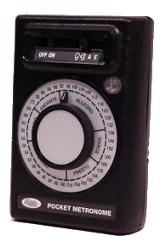
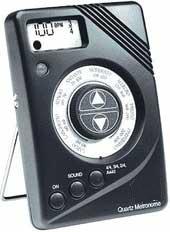
In my personal experience, Qwik Time digital LCD metronomes, which can be bought for around $20 or less, do not last very long, even under normal use. Despite their low price, I would strongly advise against buying one. There are many metronomes which cost a little more that will last for many years - perhaps even for a lifetime.
Mechanical Metronomes
The mechanical metronome, which employs a swinging pendulum was invented in 1696 by …tienne Louliť in Paris, France (yes, over 300 years ago!). His design was almost 7 feet tall. In Amsterdam in 1815, Dutch clockmaker Diedrich Nikolaus Winkel refined the metronome into a much smaller and practical form that is similar to the mechanical metronomes of today. Unfortunately for Winkel, a German inventor named Johann Maelzel essentially stole his design in 1816, refined it slightly, patented it, and marketed it very successfully. Maelzel is widely (and mistakenly) credited for inventing the modern mechanical metronome. The Maelzel Metronome (MM) - and variations thereof - is still widely used, and to this day, tempos are often indicated by "MM=tempo" on written music.
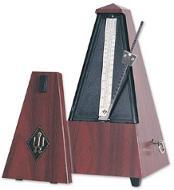

Today's mechanical metronomes operate on a wind-up mechanism. Tempo is indicated by a pendulum that swings in rhythm, producing clicks at the completion of each swing. Tempo is adjusted by sliding a weight up and down the length of the pendulum. Unfortunately, mechanical metronomes are not very practical for drummers as they are not loud enough to hear over the sound of drums. Pendulum operated metronomes vary in cost from around $30 to $100.
Drum Machines
Drum machines are programmable electronic devices which contain a multitude of drum and percussion sounds. When using a drum machine, users can program and play back rhythm patterns using various sounds contained within the unit's memory.
Reportedly, the first drum machine was the Chamberlin Rhythmate in 1949, but the first programmable drum machine was developed by the Roland corporation in 1975. The popularity of drum machines really exploded in the early 1980's, when companies such as Yamaha, Linn and Oberheim joined Roland among the industry leaders. Today, much of popular music is made with drum machines, computer based drum programs or "loops" (pre-recorded drum parts which are digitally edited and arranged).
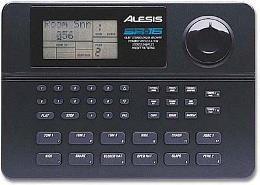
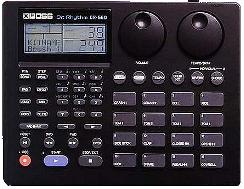
Drum machines vary greatly in features, sound quality, memory and price. Drum machines cost anywhere from $100 to well over $1000, but most reside in the $150-$350 range.
CD Metronome
With the advent and eventual accessibility of CD technology, the CD metronome came into existence. Each track on a CD metronome is a recording of a click (or similar percussive sound) at a different tempo. CD metronomes are very practical for drummers because they can be played on any CD player, Walkman, computer or DVD player. Therefore, one can easily adjust the volume in order to hear the click sounds over the sound of the drums. Also, CD metronomes can be easily navigated (without leaving the drum throne) by using a CD player's remote control.
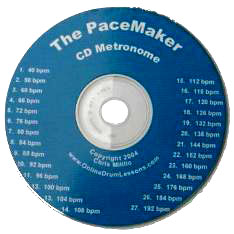
After working with a few different CD metronomes, I felt there was much room for improvement, both in sound and function. Due to the unique needs of practicing drummers, I developed the PaceMaker CD Metronome. I feel it sounds better than previous CD metronomes and unlike other CD metronomes, it includes most of the actual tempos found on traditional metronomes and in instructional materials. The PaceMaker CD Metronome can be purchased for $14.95 in the OnlineDrumLessons.com Online Store.
Making Your Choice
It is very important to consider several factors when choosing a metronome. Some of these factors are cost, ease of use, durability and last but certainly not least, the most often overlooked factor: volume. I can't even count how many times my students have come to me frustrated because they can't hear their metronome when practicing on the drums. The unfortunate result is that they are very reluctant to use the metronome and their development suffers for it.
Pocket or mechanical metronomes are simply not loud enough to hear over the volume of a snare drum or drum set, even when using the headphone jack. Drum machines, while being excellent practice tools, can be difficult to program and are too expensive for anyone but the most serious, dedicated student. For these reasons, among others, the PaceMaker CD Metronome has become my first choice for teaching and practicing. It has become very popular among my students and they seem to really enjoy using it.
I hope this article has helped to shed some light on the various timekeeping devices available today. These devices are extremely useful in your quest to become a better drummer. Best of luck to you!
